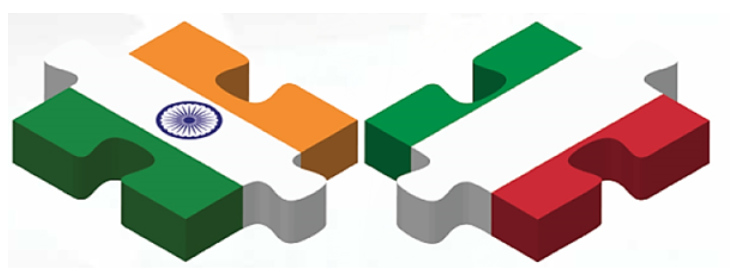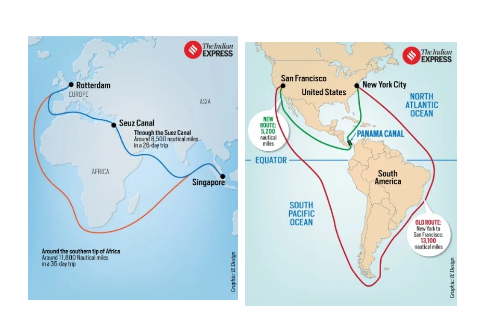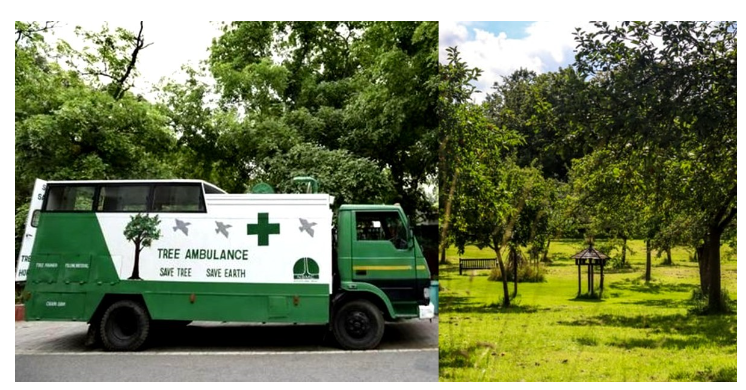Friday, 5th January 2024
India’s Steel Sector
In News: The Steel Sector has experienced significant expansion over the years, with India emerging as a prominent global player in steel production.

State of the Steel Sector in India
- Current Scenario
- In the fiscal year 2022-23, India's crude steel production reached 125.32 million tonnes (MT), with finished steel production at 121.29 MT.
- Significance
- Steel is a globally indispensable material, and the iron and steel industry serves as a foundational producer.
- The steel sector plays a pivotal role in critical domains such as construction, infrastructure, automotive, engineering, and defense.
- It contributes significantly to India's GDP, accounting for 2% in FY 21-22.
- Major Producing States
- Key steel-producing states in India include Odisha, leading the pack, followed by Jharkhand and Chhattisgarh.
- Karnataka, Maharashtra, Gujarat, and West Bengal also contribute significantly.
Government Initiatives for Sector Growth
- Inclusion of Specialty Steel in PLI Scheme
- The government has allocated Rs 6322 crore over a 5-year period to encourage the manufacturing of specialty steel, attract investments, and promote technological advancements in the sector.
- Green Steel Making
- The Ministry of Steel has established 13 Task Forces, engaging industry, academia, and other stakeholders to strategize on decarbonizing the steel sector.
- The Ministry of New and Renewable Energy's National Green Mission, focused on green hydrogen production, involves the steel sector as a stakeholder.
- Adoption of Best Available Technologies
- The steel sector is embracing globally recognized Best Available Technologies (BAT) in its modernization and expansion projects.
- Ministry's Engagement with PM Gati Shakti National Master Plan
- The Ministry of Steel has integrated BISAG-N's capabilities into the PM Gati Shakti National Master Plan, incorporating geolocations of over 2000 steel units.
- This data aids in planning infrastructure developments such as railway lines, inland waterways, highways, ports, and gas pipelines.
- Steel Scrap Recycling Policy
- The Steel Scrap Recycling Policy (SSRP), implemented in 2019, provides a framework to facilitate the establishment of metal scrapping centers for scientific processing and recycling of ferrous scrap.
- National Steel Policy 2017
- The National Steel Policy 2017 outlines a comprehensive roadmap for long-term growth in the Indian steel industry by 2030-31.
- Government initiatives like Gati-Shakti Master Plan and 'Make-in-India' contribute to increased steel demand.
- Steel and Steel Products (Quality Control) Order
- The Ministry of Steel has introduced the Steel Quality Control Order, ensuring the availability of quality steel by prohibiting sub-standard or defective steel products, both domestically and through imports.
- Safety in the Iron & Steel Sector
- Following extensive consultations, a set of 25 common minimum Safety Guidelines for the Iron & Steel Sector has been formulated.
- These guidelines align with global standards and meet the requirements of the ILO Code of practice on safety in the industry.
- National Metallurgist Award
- The Ministry of Steel presents the National Metallurgist Award to acknowledge the outstanding contributions of metallurgists in the iron and steel sector.
|
UPSC Previous Year Questions Prelims (2014) Q. Which of the following are some important pollutants released by steel industry in India?
Select the correct answer using the code given below: (a) 1, 3 and 4 only Ans: (d) Exp:
Mains (2020) Q1. Account for the present location of iron and steel industries away from the source of raw material, by giving examples. Mains (2014) Q2. Account for the change in the spatial pattern of the Iron and Steel industry in the world. |
Source: PIB
Kuno Welcomes the Arrival of Three Cubs as Namibian Cheetah Aasha Successfully Gives Birth
In News: Aasha, the Namibian cheetah, has given birth to three cubs at Kuno National Park in the Sheopur district of Madhya Pradesh, showcasing successful acclimatization.
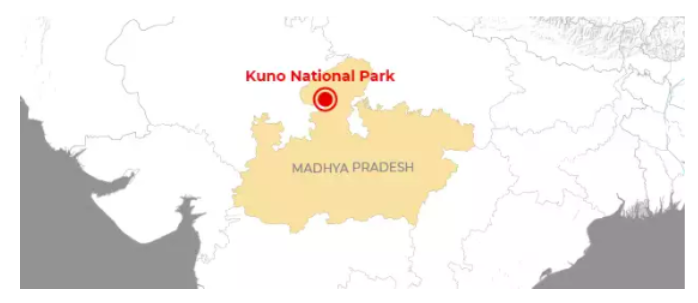
Cheetah Reintroduction Plan - Overview
- Initiating Cheetah Reintroduction Discussions
- In 2009, the Wildlife Trust of India initiated discussions to reintroduce cheetahs to India, marking the beginning of Project Cheetah.
- Action Plan for Reintroduction
- Under the "Action Plan for Reintroduction of Cheetah in India," 50 cheetahs will be brought from African countries to various national parks over a 5-year period.
- Choosing Kuno Palpur National Park
- Kuno Palpur National Park (KNP) in Madhya Pradesh is identified as the most suitable site due to its habitat quality and ample prey base.
- It can potentially support 21 cheetahs and is unique for relocating villages from within the park, making it an ideal habitat for various big cat species.
- Other Recommended Sites
- Additional recommended sites include Nauradehi Wildlife Sanctuary, Gandhi Sagar Wildlife Sanctuary - Bhainsrorgarh Wildlife Sanctuary complex in Madhya Pradesh, Shahgarh bulge in Jaisalmer, Rajasthan, and Mukundara Tiger Reserve in Rajasthan.
- Implementation of Reintroduction
- As part of the project, 20 cheetahs, comprising 8 from Namibia and 12 from South Africa, were introduced in KNP to establish a free-ranging population after a 70-year extinction period in India.
- Significance of Cheetah Reintroduction
- Beyond conserving the cheetah, the initiative is crucial for ecosystem balance, preserving prey species and endangered grassland inhabitants.
- Cheetahs pose no threat to humans and do not harm large livestock.
- Bringing Cheetahs from Southern Africa
- Southern African cheetahs are chosen due to the critically endangered status of the locally extinct Cheetah-subspecies in India.
- The genetic diversity and ancestral lineage of Southern African Cheetahs make them suitable for India's reintroduction program.
- Challenges and Supreme Court's Decision
- There are debates about the scientific validity of bringing African Cheetahs into India.
- The Supreme Court of India, in 2020, permitted an experimental release of cheetahs in a suitable habitat.
Source: IE
Bharatmala Phase-1: Deadline Extended
In News: The government has decided to extend the deadline for the completion of the Bharatmala Pariyojana Phase-I, until the fiscal year 2027-28.
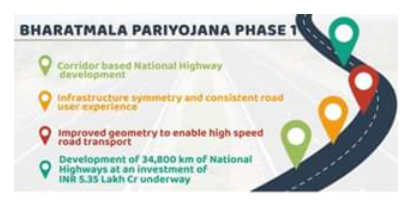
Bharatmala Pariyojana Overview
- About Bharatmala Pariyojana
- Bharatmala Pariyojana is a comprehensive initiative launched by the Ministry of Road Transport and Highways, serving as an umbrella program.
- Phase-I Announced in 2017
- The first phase of Bharatmala, declared in 2017, initially targeted completion by 2022.
Key Features of Bharatmala
Bharatmala is designed to enhance the efficiency of existing infrastructure, promote multi-modal integration, bridge gaps in connectivity, and integrate National and Economic Corridors. The program comprises six pivotal features:
- Economic Corridors
- Enhances connectivity between vital production and consumption centers.
- Inter-corridor and Feeder Routes
- Ensures first mile and last mile connectivity.
- National Corridor Efficiency Improvement
- Focuses on lane expansion and decongestion of existing National Corridors.
- Border and International Connectivity Roads
- Improves border road infrastructure for better maneuverability and increased trade with neighboring countries.
- Coastal and Port Connectivity Roads
- Boosts port-led economic development through connectivity to coastal areas, fostering tourism and industrial growth.
- Green-field Expressways
- Addresses traffic congestion with green-field expressways.
Project Status
- As of November 2023, 42% of the project, equivalent to 15,045 km, has been successfully completed.
Challenges Faced
- The project encounters challenges such as the rising cost of raw materials, increased land acquisition expenses, construction complexities of high-speed corridors, and fluctuations in Goods and Services Tax rates.
Strategies for Progress
- Cost Management for Raw Materials
- Implement strategic procurement methods to secure raw materials at competitive prices.
- Engage in negotiations with suppliers to ensure favorable rates, especially during market fluctuations.
- Efficient Land Acquisition
- Implement transparent and efficient land acquisition practices to minimize compensation disputes.
- Explore alternatives like land pooling and community engagement to streamline the acquisition process.
- High-speed Corridor Optimization
- Conduct thorough feasibility studies before incorporating high-speed corridors.
- Optimize corridor designs to balance functionality with cost-effectiveness.
- GST Policy Advocacy
- Advocate for stable and predictable GST policies to minimize uncertainties.
- Engage with government authorities to provide industry insights on the impact of tax rate changes.
|
UPSC Previous Year Questions Prelims (2017) Q. With reference to ‘National Investment and Infrastructure Fund’, which of the following statements is/are correct?
Select the correct answer using the code given below: (a) 1 only Ans: (d)
Mains (2021) Q. “Investment in infrastructure is essential for more rapid and inclusive economic growth.” Discuss in the light of India’s experience. |
Source: FE
Indian Science Congress been postponed
In News: The Indian Science Congress, scheduled for its traditional starting date of January 3, has been postponed, and the five-day event will not commence as planned.
Indian Science Congress (ISC) - Overview
- About ISC
- The Indian Science Congress (ISC) stands as a unique event in the country, providing a platform for scientific communities to engage with students and the general public on various science-related matters.
- Organized by ISCA
- The event is orchestrated by the Indian Science Congress Association (ISCA), an independent body supported by the Department of Science and Technology (DST) in the central government.
- A Calendar Fixture
- Regarded as the largest gathering of scientists and students, the Science Congress is an annual five-day event, firmly entrenched in the Prime Minister's calendar, spanning from January 3 to 7.
- Historical Origin
- The inaugural session of the Indian Science Congress took place in 1914 at the Asiatic Society premises in Calcutta.
- Challenges Faced by ISC
- In recent times, the ISC has faced criticism for various issues, including a lack of substantial discussions, the promotion of pseudoscience, extravagant claims by certain speakers, and a perceived absence of meaningful outcomes.
- Consequently, there have been calls from prominent scientists to discontinue the event or withdraw government support.
- Government's Limited Role
- The ISCA, functioning independently, receives government support in the form of an annual grant for organizing the Science Congress.
- However, the government has no involvement in selecting panelists, speakers, or the content presented.
- Despite this, the association's close association with the government leads to scrutiny and criticism whenever controversies arise.
- Postponement of ISC - Unprecedented Move
- The postponement of the Indian Science Congress is unprecedented, excluding the two years following the Covid-19 outbreak in 2021 and 2022.
- PM's Involvement
- Traditionally inaugurated by the Prime Minister, the Science Congress holds a permanent spot on the PM's calendar and serves as a significant public engagement at the start of the new year.
- Reasons Behind Postponement
- The postponement stems from an ongoing disagreement between the Indian Science Congress Association (ISCA) and the Department of Science and Technology (DST) within the Union Ministry of Science and Technology.
- The DST withdrew funding in September 2023, citing financial irregularities, leading to a legal dispute with the ISCA challenging the directive to cease government funds for the Science Congress.
- This disagreement has escalated and remains unresolved.
Source: IE
Sickle Cell Disease - Edukemy Current Affairs
In News: The National Sickle Cell Anaemia Elimination Mission has screened over 1 crore individuals for Sickle Cell Disease (SCD).

Sickle Cell Disease (SCD) - Overview
- About Sickle Cell Disease
- SCD is a collection of hereditary red blood cell (RBC) disorders characterized by abnormal hemoglobin, causing RBCs to adopt a rigid, sickle-like shape instead of their normal round form.
- Symptoms of Sickle Cell Disease
- Common symptoms of Sickle Cell Disease include chronic anemia leading to fatigue, weakness, and paleness, as well as painful episodes (sickle cell crisis) that result in sudden and intense pain in various parts of the body.
- Other symptoms may include delayed growth and puberty.
- Treatment Options
- Several treatment methods are available for managing Sickle Cell Disease:
- Blood Transfusions
- Alleviate anemia and reduce the risk of pain crises.
- Hydroxyurea
- Medication to decrease the frequency of painful episodes and prevent long-term complications.
- Bone Marrow or Stem Cell Transplantation
- Another viable treatment option.
- Government Initiatives Addressing SCD
- The government has undertaken initiatives to combat Sickle Cell Disease:
- Operational Guidelines (2016)
- Released technical operational guidelines for the prevention and control of sickle cell anemia.
- State Haemoglobinopathy Mission (Madhya Pradesh)
- Established to address challenges in screening and managing the disease within the state.
- Operational Guidelines (2016)
- Anaemin Mukt Bharat Strategy
- The government has implemented the Anaemin Mukt Bharat Strategy as part of its comprehensive approach to combat SCD and ensure a nation free from anemia.
|
UPSC Previous Year Questions Prelims (2023) Q. Consider the following statements in the context interventions being undertaken under Anaemin Mukt Bharat Strategy:
How many of the statements given above are correct? (a) Only one Ans: (c) Exp: Interventions of Anaemia Mukt Bharat:
|
Source: PIB
Expansion of PLI Scheme for Automobiles and Auto Components
In News: The Ministry of Heavy Industries has extended the Production Linked Incentive (PLI) Scheme for Automobiles and Auto Components by one more year, enabling incentives for five consecutive financial years, starting from 2023-24.
Production Linked Incentive Scheme (PLI) - Overview
- About PLI Scheme
- The PLI scheme is a government initiative in India designed to provide financial incentives to companies based on the incremental sales of products manufactured within the country.
- Its primary objectives include boosting domestic manufacturing, fostering job creation, promoting exports, facilitating technology transfer, and reducing dependence on imports.
- Key Features of PLI Scheme
- Sector-specific Focus
- The scheme currently operates in 14 key sectors, encompassing mobile manufacturing, medical devices, automobiles and auto components, pharmaceuticals, specialty steel, telecom & networking products, electronic products, white goods (ACs and LEDs), food products, textile products, solar PV modules, advanced chemistry cell (ACC) battery, and drones and drone components.
- Incentive Rate
- The incentive rate varies based on the sector and product category, ranging from 4% to 6% of incremental sales.
- Sector-specific Focus
Status of the Automobile Sector in India
- India holds the position of the world's third-largest automobile market, contributing to 5.41% of the total FDI inflow, as reported in the September 2023 DPIIT Report. The Electric Vehicle market is anticipated to exhibit a CAGR of 49% from 2022 to 2030, with expectations to generate 5 million direct and indirect jobs by 2030.
- Related Government Initiatives
- FAME Scheme (Faster Adoption and Manufacturing of Hybrid and Electric Vehicles)
- A government initiative aimed at promoting the adoption of electric vehicles and enhancing the manufacturing of hybrid and electric vehicles in the country.
- Automotive Mission Plan 2016-26 (AMP 2026)
- A strategic roadmap outlined by the government to drive sustainable growth and development in the automotive sector until 2026.
- FAME Scheme (Faster Adoption and Manufacturing of Hybrid and Electric Vehicles)
UPSC Previous Year Questions
Prelims (2023)
Q. Consider, the following statements:
Statement-I: India accounts for 3.2% of global export of goods.
Statement-II: Many local companies and some foreign companies operating in India have taken advantage of India's ‘Production-linked Incentive’ scheme.
Which one of the following is correct in respect of the above statements?
(a) Both Statement-I and Statement-II are correct and Statement-II is the correct explanation for Statement-I
(b) Both Statement-I and Statement-II are correct and Statement-II is not the correct explanation for Statement-I
(c) Statement-I is correct but Statement-II is incorrect
(d) Statement-I is incorrect but Statement-II is correct
Ans: (d)
Source: PIB
Kavaratti Island
In News: Recently, the Prime Minister was warmly greeted in Kavaratti, Lakshadweep, as he arrived to inaugurate and lay the foundation for multiple development projects.
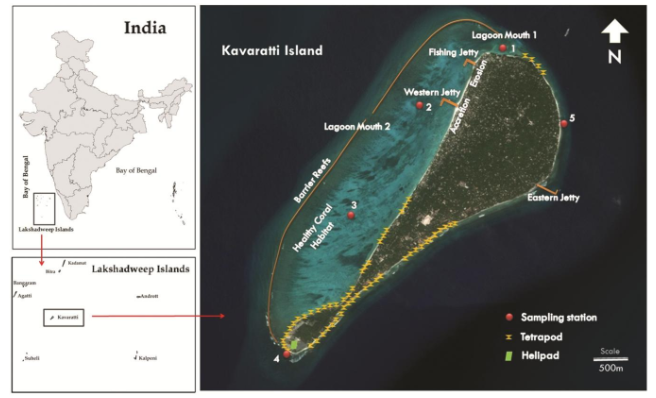
Kavaratti Island: Overview
- Geographical Significance
- Kavaratti, the capital of Lakshadweep and the smallest Union Territory in India, stands as the most developed island in the region.
- Positioned 360 km off the Kerala coast, it holds a central location within the Lakshadweep archipelago, lying between Agatti Island to the west and Andrott Island to the east.
- Geographical Features
- Covering an area of 4.22 sq km, Kavaratti boasts a maximum length of 5.8 km and a width of 1.6 km.
- The island's elevation ranges from 2 to 5 m above mean sea level on the western side and 2 to 3 m on the eastern side.
- A shallow lagoon graces the western side, while coconut palms thrive on the northern end.
- The island encompasses 12 atolls, five submerged banks, and three coral reefs. Interestingly, Kavaratti houses a small inland lake at its northern tip.
- Cultural and Architectural Highlights
- Kavaratti town is renowned for its mosques adorned with carved wooden pillars and roofs, as well as intricately carved stones in its graveyards.
- Notably, the island has the highest percentage of non-islander residents.
- Language and Cultural Diversity
- The languages spoken on Kavaratti include Malayalam and Mahl, reflecting the cultural diversity of its populace.
- Smart City Initiative
- Kavaratti has been chosen as one of the hundred Indian cities earmarked for development as a smart city under the flagship Smart Cities Mission, emphasizing its commitment to modern urban planning and innovation.
Source: LY
Swadesh Darshan Scheme
In News: The Swadesh Darshan 2.0 scheme now incorporates the Debrigarh Wildlife Sanctuary, as announced by the Ministry of Tourism.
Swadesh Darshan Scheme: Overview
- Inception and Objectives
- Launched in 2015 by the Ministry of Tourism, Government of India, the Swadesh Darshan Scheme aims to foster sustainable and responsible tourism destinations across the country.
- This 100% centrally funded scheme provides financial assistance to State governments, Union Territory Administrations, or Central Agencies for the development of tourism infrastructure.
- Implementation and Responsibilities
- Under the scheme, the Ministry of Tourism extends financial support, and the development, operation, and maintenance of sanctioned projects fall under the purview of the respective State Government or UT Administration.
- Swadesh Darshan 2.0 Transformation
- The Ministry of Tourism has revitalized the Swadesh Darshan scheme, now known as Swadesh Darshan 2.0 (SD2.0).
- This enhanced version focuses on the development of sustainable and responsible tourist destinations, covering diverse aspects such as tourism infrastructure, services, human capital development, destination management, and promotion.
- The scheme is reinforced by policy and institutional reforms.
- Objectives of Swadesh Darshan 2.0
- The primary goals of the Swadesh Darshan 2.0 scheme include encouraging increased private sector investment in tourism and hospitality.
- It also envisions fostering greater Public Private Partnerships (PPPs) in the tourism sector, especially in the operation and maintenance of assets created under the scheme.
Source: TOI
Savitribai Phule: Education Pioneer
In News: January 3rd marks the annual celebration of Savitribai Phule Jayanti in India.

Savitribai Phule: Champion of Education and Social Reform
- Early Life and Education
- Savitribai Phule, born on January 3, 1831, in a small village in Maharashtra, was a renowned Indian social reformer, poet, and a significant voice in the country's freedom struggle. She actively participated in the women's liberation movement.
- Trailblazing Achievements
- Trained at Ms. Farar's Institution and Ms. Mitchell's school, Savitribai became India's first female teacher.
- In collaboration with her husband, Jyotirao Phule, she established the nation's first school for women in Pune in 1848.
- Despite societal resistance, by 1851, they were running 18 schools for children of different castes, empowering 150 girls.
- Educational Advocacy
- The Phule couple established educational trusts and received acknowledgment from the British government for their educational endeavors. Savitribai played a crucial role in Satyashodhak Samaj (1873) fighting for equality.
- Advocacy for Women’s Rights
- Initiating the Mahila Seva Mandal in 1852, Savitribai aimed to raise awareness about women's rights, uniting members across castes.
- She was a vocal proponent for widows' rights, campaigned against oppressive customs like dowry, and organized strikes against head shaving.
- Social Reforms and Activism
- In 1863, Jyotirao and Savitribai founded Balhatya Pratibandhak Griha, India's first home opposing infanticide, aiding pregnant Brahmin widows and rape victims.
- Savitribai authored notable poems and advocated education for the oppressed classes.
- Legacy and Commemoration
- Savitribai Phule's birth anniversary on January 3 is celebrated as Savitribai Phule Jayanti, honoring her profound contributions to education and social equality.
Source: IT
India's Debt Burden Dispute
In News: The International Monetary Fund (IMF) has made two significant observations that have brought India's economic landscape into focus.
IMF's Evaluation of India's Economic Landscape
- Exchange Rate Shift
- The IMF's move to reclassify India's exchange rate regime, shifting from floating to a stabilised arrangement, is a notable assessment.
- Stabilised Arrangement Interpretation
- The term "stabilised arrangement" raises concerns about excessive management, prompting questions about currency flexibility and alignment with market forces.
- Global Debt Challenges in Context
- Dual Role of Debt: Catalyst and Constraint to Development
- Historically, government borrowings globally have propelled development, supporting infrastructure, social programs, and economic growth.
- Yet, the IMF's apprehensions shed light on potential drawbacks, including restricted financing access, rising borrowing costs, currency devaluation, and sluggish growth, turning debt from an accelerator to a hindrance.
- UN Dilemma: Servicing Debt vs. Serving People
- The UN's assertion that nations face a dilemma between servicing debt or serving people underscores the intricate challenge of managing debt for sustainable development.
- Rising Global Public Debt Trends
- Global public debt has surged over fourfold since 2000, surpassing the tripling of global GDP over the same period.
- In 2022, global public debt reached a staggering USD 92 trillion, with developing countries contributing nearly 30%.
- Significantly, China, India, and Brazil constitute 70% of this share, reflecting accelerated debt in developing nations due to heightened development needs, exacerbated by the COVID-19 pandemic, cost-of-living challenges, and climate change impacts.
- Asymmetric Debt Burden on Developing Nations
- Developing countries often face higher interest rates, regardless of exchange rate fluctuations, with countries in Africa borrowing at rates much higher than the United States and Germany, challenging debt sustainability.
- Increasing Debt Levels and IMF's Insight
- The number of countries grappling with high debt levels has risen from 22 in 2011 to 59 in 2022, emphasizing persistent debt challenges in developing nations.
- Understanding IMF's India Projections in a Global Context
- India's debt challenges, as projected by the IMF, should be considered within the wider global scenario of mounting debt, recognizing the complex interconnections of economic phenomena.
Challenges for India's Economy
- Escalating Public Debt
- India's central government debt reached ₹155.6 trillion, constituting 57.1% of GDP by March 2023, with state government debts accounting for approximately 28% of GDP.
- Despite assertions from the Finance Ministry regarding marginal increases in the public debt-to-GDP ratio, recent figures indicate a return to 81%, surpassing FRBMA targets.
- Striking a Balance for Sustainable Public Debt
- India grapples with the challenge of maintaining public debt within sustainable levels, with IMF projections hinting at the possibility of general government debt reaching 100% of GDP by fiscal 2028 under adverse circumstances.
- This underscores the necessity for meticulous debt management strategies to avert unsustainable economic levels.
- Stagnant Credit Ratings
- While India is recognized as the fastest-growing major economy, sovereign investment ratings, maintained at 'BBB-' since August 2006 by Fitch Ratings and S&P Global Ratings, indicate persistent challenges.
- Stagnancy is attributed to weak fiscal performance, a burdensome debt stock, and low per capita income, illustrating the complex dynamics influencing India's creditworthiness.
- Emerging Fiscal Hurdles
- Disruptions from the COVID-19 pandemic have contributed to the current high debt-GDP ratio, with fiscal challenges looming.
- India Ratings and Research (IR&R) anticipates possible fiscal slippage in FY24, citing increased expenditure on employment guarantee schemes and subsidies.
- Challenges of managing short-term issues amid election dynamics pose a crucial test for maintaining fiscal discipline and avoiding worst-case scenarios.
Forward Strategy
- While the exchange rate reclassification raises apprehensions about potential over-management, the emphasis on debt sustainability underscores a broader call for prudence in fiscal policy management.
- IMF's insights indicate a delicate balancing act for India—maintaining a stable exchange rate while ensuring the long-term sustainability of debt.
- The imperative for new and preferably concessional financing sources, increased private sector investment, and the implementation of carbon pricing or equivalent mechanisms to address long-term risks is highlighted.
Concluding Thoughts
- In navigating the complex challenges outlined by the IMF, India finds itself at a pivotal juncture, demanding a strategic approach to economic management.
- The IMF's observations, covering concerns about debt sustainability and the reclassification of the exchange rate regime, underscore the necessity for nuanced decision-making and comprehensive long-term planning.
- The reclassification implies a perception that the rupee's movements are managed in a controlled and stabilised environment, potentially attributed to interventions by the central bank (RBI).
- A significant worry highlighted by the IMF pertains to the long-term sustainability of India's debts.
- In adverse scenarios, the report projects India's general government debt (encompassing central and state governments) to potentially reach 100% of GDP by fiscal 2028.
- This projection emphasizes the urgency for meticulous debt management strategies, especially considering India's significant investment needs for climate change mitigation and resilience against natural disasters.
- The IMF's observations on India's economic challenges are contextualized within the global scenario of rising public debts, recognizing the interconnected nature of economic phenomena.
Source: TH
Share the article
Edukemy’s Current Affairs Quiz is published with multiple choice questions for UPSC exams
MCQ
Get Latest Updates on Offers, Event dates, and free Mentorship sessions.

Get in touch with our Expert Academic Counsellors 👋
FAQs
UPSC Daily Current Affairs focuses on learning current events on a daily basis. An aspirant needs to study regular and updated information about current events, news, and relevant topics that are important for UPSC aspirants. It covers national and international affairs, government policies, socio-economic issues, science and technology advancements, and more.
UPSC Daily Current Affairs provides aspirants with a concise and comprehensive overview of the latest happenings and developments across various fields. It helps aspirants stay updated with current affairs and provides them with valuable insights and analysis, which are essential for answering questions in the UPSC examinations. It enhances their knowledge, analytical skills, and ability to connect current affairs with the UPSC syllabus.
UPSC Daily Current Affairs covers a wide range of topics, including politics, economics, science and technology, environment, social issues, governance, international relations, and more. It offers news summaries, in-depth analyses, editorials, opinion pieces, and relevant study materials. It also provides practice questions and quizzes to help aspirants test their understanding of current affairs.
Edukemy's UPSC Daily Current Affairs can be accessed through:
- UPSC Daily Current Affairs can be accessed through Current Affairs tab at the top of the Main Page of Edukemy.
- Edukemy Mobile app: The Daily Current Affairs can also be access through Edukemy Mobile App.
- Social media: Follow Edukemy’s official social media accounts or pages that provide UPSC Daily Current Affairs updates, including Facebook, Twitter, or Telegram channels.


